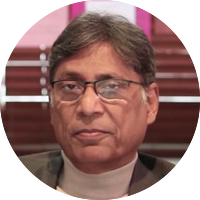Circle of Connoisseurs (Halqai-i Arbaab-e Zauq)
A Proplogue
The name, Halqai- Arabaab-e Zauq (Circle of Connoisseurs), is amply suggestive of its essential nature and scope. The poets who came together to form this Halqa were clearly different in their orientation and outlook compared with the progressive poets who were writing the poetry of the same kind during the same period. The Halqa poets had no slogans to raise, no political ideology to follow; they only had the poem to engage with as a serious work of art. They were more preoccupied with form and language—the poem as a technically proficient work of craftsmanship that stood for its own testimony. A poem for them was an attempt at re-defining the poem itself that was typically modernist in tone, tenor, and style.
Major Practioners
The Halqa comprised N. M. Rashed, Meeraji, Gopal Mittal, Yusuf Zafar, Qayyum Nazar, Mukhtar Siddiqui and Zia Jalandhari, even though it also had Mohammad Deen Taseer and Patras Bukhari, as its unacknowledged votaries. The group posited a poetics that was entirely different from the one championed by the progressive poets. It did not proclaim any political intentions, nor declare affiliations to any given ideology—social, political, or literary. Rather, it developed a liberal approach towards the conditions of being that defied a logical or chronological sequence. The poets of this group yearned to apprehend life’s mysteries and ambiguities which constituted its core and called for a liberal negotiation. It acknowledged the presence of baser and finer instincts in human beings, and dealt with them with greater catholicity than any kind of constraint. To keep pace with such a liberal approach towards life and its manifestations, these poets chose to liberalize the form itself and make way for blank and free verse that could bear the burden of their experience. Quite naturally, a substantial body of their poetry turned out to be obscure, and needed effort on the part of the reader to decipher them. This corresponded closely with much of the modernist poetry written then in English, French, and other languages with which their association may be justifiably established.
A Major Exemplars: N. M Rashed
N.M. Rashed’s poetry was not quite acceptable to a larger readership at the first instance but once he found certain acceptability, it started growing upon his readers steadily. On a more critical note, it might be argued that his reputation as a poet kept pace with the appearance of the three collections of his poetry –Mawara (Beyond), Iran Mein Ajnabi (Stranger in Iran), La-Insan (No-man), Guman ka Mumkin (Possible Conjecture), published between 1941 and 1977. While his first collection challenged the popular taste, it slowly and painfully worked towards acquiring a readership that could accept his poetic output which was drastically different, both in experience and technique. With each one of his collections, he gained greater ground till he came to be accepted as one of the three major vices of modernist Urdu poetry.
Rashed chose to engage with history, nature, and human instinct in his poetry and listen to unheard voices hidden from remote quarters. While rejecting age-old moral values, he initiated himself into life’s s essential spirit by joining it uninhibitedly. Poems in Iran Mein Ajnabi show how he sought meaning while alternating between past and present, as he did between the immediately perceptible and the remotely present. This brought him closer to hope and faith and to an understanding of existential reality which came out in his later poems with greater confidence.
Rashed made bolder experiments in form than others. With his rhymed and unrhymed verse and with his vocabulary shorn of conventional sound and meaning, he drew upon the myriad facets of life lived in private and in public. He drew upon shifting cultural motifs, melting geographical boundaries, quibbles of politics, failures of governance, and human values relegated to die in a limbo. In his poetic apprehension and rendition, Rashed went closer to western modernists, especially T. S. Eliot, along with whom he may be read with great profit. Both are allusive, both interrogate language and both shun popular appeal and write for the more informed readers than the ordinary ones.
Another Major Exemplar: Meeraji
In comparison with Rashed, Meeraji’s attitude towards life was that of a total bohemian. He subscribed to a non-conformist form and idiom of poetry that explored the inner recesses of human psyche. Meeraji had little regard for the conservative value system and showed as much in his eclectic and, quite often, wayward youthfulness. His free associations with objects of attention might be traced in Freudian psychoanalysis as he was naturally drawn towards exploring the mysteries of the subconscious. This made him sensational at times but he struck at the very root of the complex psychic functioning. His resorted to diverse sources which included Hindu mythology, Freud, Mirabai, Omar Khyyam, Amaru, Damodar Gupta, Edgar Allan Poe, Baudelaire and Corbiere. All of these together, defined the nature of his poetry. His amazing range of references and his ways of drawing upon them in idiosyncratic ways, underlined his typically modernist instance and expression. Greatly esoteric and experimental in nature, Meeraji reflected upon the nature of the word and structure of the poem which put his poetry in a different class altogether.
Rashed and Meeraji were poets of tough intellectual mould who drew upon a rich variety of Eastern and Western, as well as literary and extra-literary sources. They went to indigenous, spiritual and cultural sources and turned them contemporaneously relevant in their poetry. That was their way of imparting a philosophical halo to their poetry. The way they discovered their metaphors and symbols, their language and ideology, their form and technique, Rashed and Meeraji might best be appreciated as avant garde poets, closely comparable to their western counterparts. Their significance may be traced in how they established a robust tradition of modernism in Urdu poetry and how the poets who wrote after them, closely drew upon them.

